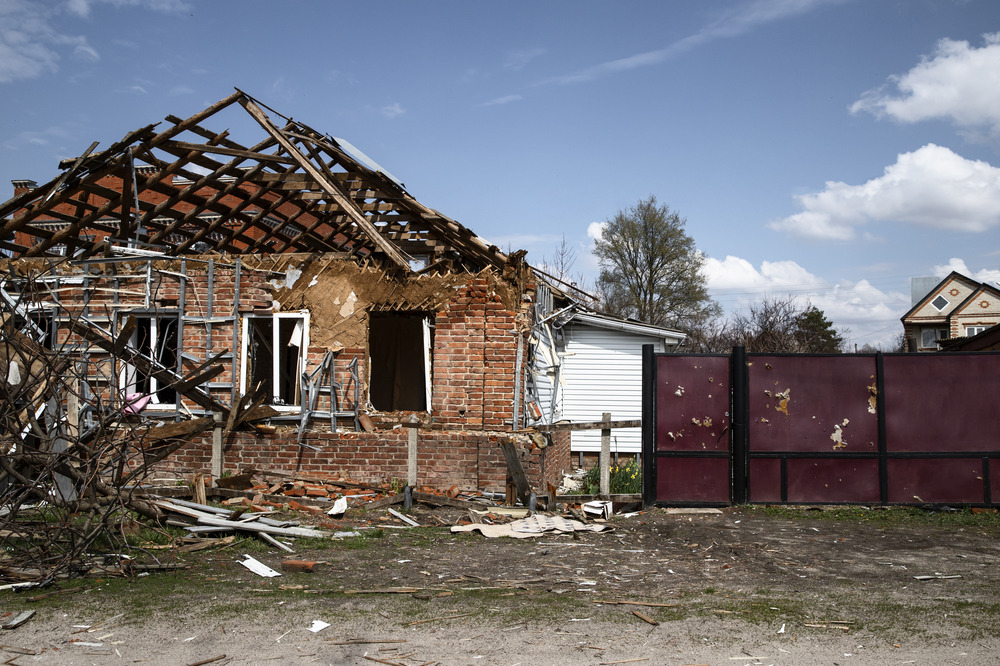
How to Prepare Your Roof for Severe Weather
Severe weather can strike in many forms—hailstorms, heavy snow, high winds, and relentless rain—all of which put roofs to the test. A proactive approach to roof preparation is crucial, especially as the United States faced 27 weather and climate disasters in 2024, each causing over $1 billion in damages. It’s possible to safeguard against nature’s toughest challenges while extending the lifespan of the roof itself by focusing on storm-proof roofing techniques and practical weather-resistant roof tips.
Here are five tips on protecting a roof from severe weather.
Table of Contents
Key Takeaways✔ Regular roof inspections help identify hidden damage early and prevent costly repairs. ✔ Upgrading to durable materials like impact-resistant shingles enhances protection against hail, wind, and heavy snow. ✔ Clean and functional gutters prevent water pooling, ice dams, and additional roof strain during storms. ✔ Trimming overhanging branches reduces the risk of roof punctures, debris accumulation, and snow buildup. ✔ Securing roofing accessories and temporary covers prevent leaks and damage from high winds or heavy rainfall. ✔ Preparing for professional roof inspections ensures thorough assessments and catches subtle, hidden damage. ✔ Using advanced storm-proof roofing techniques creates a weather-resistant roof ready for any severe weather challenge. |

1. Inspect the Roof for Potential Damage
Roof preparation for severe weather starts with regular inspections to identify and address vulnerabilities before storms strike. Even minor issues like cracked shingles or rusted flashing can lead to significant damage during hailstorms, heavy rains, or high winds. Identifying and addressing these problems early ensures a weather-resistant roof ready to withstand harsh conditions.
Why Regular Inspections Are Critical
- Spot Hidden Weaknesses: Small cracks or loose shingles might seem insignificant but can worsen under the pressure of heavy rain or hail. These unnoticed issues often allow water to seep into the roof deck, leading to rot and structural damage.
- Prevent Costly Repairs: Timely inspections minimize the risk of severe weather turning manageable problems into expensive fixes. A damaged roof left unchecked may require partial or full replacement after a storm.
- Ensure Long-Term Durability: Regular checks help maintain the integrity of storm-proof roofing systems. Routine upkeep keeps roofing materials in optimal condition, reducing the likelihood of sudden failures.
How to Conduct a Thorough Inspection
- Examine Shingles and Flashing: Look for curling, missing, or cracked shingles, and inspect flashing for rust or gaps. Damaged flashing around vents or chimneys is a common entry point for water during storms. Simple weather-resistant roof tips like sealing flashing and repairing damaged shingles can prevent leaks during severe storms.
- Check for Sagging or Uneven Areas: These may indicate structural issues that can worsen under heavy snow or high winds. Early detection allows for reinforcements before severe weather causes collapse or further damage.
- Inspect Gutters and Downspouts: Clear out debris and ensure water flows away from the roof and foundation. Blocked gutters can lead to water pooling, increasing the risk of leaks and ice dams in cold conditions.
2. Strengthen Roof Materials for Severe Weather
Upgrading roof materials is a practical way to enhance durability and prepare for extreme conditions. From impact-resistant shingles to reinforced underlayment, these improvements protect against hailstorms, heavy snow, and strong winds. Following weather-resistant roof tips ensures that roofs are better equipped to handle heavy rain, hail, and strong winds.
Why Durable Materials Are Essential
- Protect Against Hailstorms: Effective roof preparation for severe weather includes upgrading materials like impact-resistant shingles to handle hail and heavy winds. This minimizes damage and the need for post-storm repairs.
- Handle Heavy Snow Loads: Reinforced roof decking supports the weight of accumulated snow, preventing sagging or collapse. Strengthened materials can withstand snow that would otherwise strain weaker structures.
- Resist High Winds: Roofing systems with secure, high-quality fasteners are less likely to be ripped apart during powerful windstorms. Wind-rated materials provide additional security in storm-prone areas.
How to Upgrade Roof Materials
- Install Waterproof Membranes: Adding a waterproof barrier beneath shingles protects against rain infiltration, especially during prolonged downpours. This layer safeguards the roof deck and interior.
- Choose Metal Roofing for Longevity: Metal roofs are highly resistant to wind and snow, making them a popular choice for storm-proof roofing. Their sleek surfaces also allow snow to slide off more easily, reducing stress on the structure.
- Use Hail-Resistant Coatings: Special coatings applied to shingles or metal roofing help absorb hail impact and prevent surface damage. These coatings are particularly useful in areas prone to frequent hailstorms. Applying roof coatings and upgrading to durable materials are among the most effective weather-resistant roof tips for long-term protection.
3. Maintain and Clear Gutters Regularly
Clean and functional gutters play a vital role in roof preparation for severe weather. They channel rainwater and melted snow away from the roof and foundation, preventing water damage. Neglecting this simple maintenance task can lead to pooling water, leaks, and ice dams during extreme weather events.
Why Gutter Maintenance is Crucial
- Prevent Ice Dams in Cold Weather: When gutters are clogged, melted snow can refreeze along the roof edge, forming ice dams. These dams block water flow and increase the risk of leaks and structural damage.
- Protect Against Heavy Rainfall: Clear gutters prevent water from backing up onto the roof or overflowing near the foundation. This reduces the likelihood of water seeping into the roof deck or basement.
- Reduce Weight Stress During Snowstorms: Heavy, waterlogged debris in gutters adds unnecessary weight that can cause them to pull away from the roof. Maintaining gutters ensures they remain securely attached during snowstorms.
How to Keep Gutters Functional
- Schedule Seasonal Cleaning: Remove leaves, dirt, and other debris at least twice a year, ideally in spring and fall. Regular cleaning prevents blockages that lead to water damage. Maintaining gutters and trimming overhanging trees are practical weather-resistant roof tips that improve a roof’s durability.
- Install Leaf Guards: Gutter guards reduce the frequency of cleaning by keeping debris out while allowing water to flow freely. These are particularly effective in areas with frequent storms or dense foliage.
- Check Gutter Connections: Ensure that gutters are securely fastened and slope correctly to direct water away from the roof. Loose or improperly angled gutters can exacerbate water drainage issues.
4. Trim Surrounding Trees
Overhanging branches pose a significant risk to roofs during severe weather. High winds, hail, and heavy snow can cause branches to snap, damaging shingles or puncturing the roof. Proactive tree maintenance reduces the likelihood of such incidents, protecting both the roof and the property below.
Why Tree Trimming is Necessary
- Prevent Roof Punctures During Windstorms: Loose or dead branches are easily torn off by high winds, turning them into projectiles. Keeping trees trimmed minimizes the chance of impact damage.
- Reduce Hailstorm Damage: Dense canopies can drop debris like twigs or small branches during hailstorms, increasing the risk of shingle dents or cracks. Clearing these weak spots minimizes damage.
- Minimize Snow Accumulation Risks: Overhanging branches can shed heavy snow onto the roof, increasing weight strain. Removing these hazards reduces the stress on the roof structure during snowstorms.
How to Safely Trim Trees
- Remove Dead or Weak Branches: Regularly inspect trees and remove any dead or damaged branches that could break off during storms. Focus on those close to or above the roof.
- Create Clearance Around the Roof: Trim branches to maintain at least six feet of clearance from the roof. This prevents direct contact and reduces debris buildup.
- Hire Professionals for Large Trees: For mature or difficult-to-reach trees, consult a professional arborist. They can ensure safe and effective trimming without endangering the property.
5. Reinforce Roofing Accessories and Attachments
Roofing accessories such as vents, satellite dishes, and skylights are often vulnerable during severe weather. If these components are not properly secured, they can loosen, detach, or cause leaks. Reinforcing these areas strengthens the roof’s overall resilience and prevents weather-related failures.
Why Securing Accessories is Important
- Protect Against Leaks During Rainstorms: Poorly sealed accessories are common entry points for water during heavy rain. Reinforcements prevent water from seeping into the roof.
- Prevent Damage from High Winds: Strong winds can dislodge unsecured components, leaving gaps that compromise the roof’s integrity. Securing attachments reduces the risk of wind damage.
- Enhance Hailstorm Resistance: Reinforced skylights and vents are less likely to crack or dent under hail impact. Strengthening these areas ensures a consistent, weather-resistant roof.
How to Reinforce Accessories
- Seal Skylights with Weatherproof Caulk: Apply a durable sealant around skylights to block water entry during storms. Ensure seals are intact and replace them if cracked or worn.
- Secure Vents and Flashing: Tighten all screws and bolts on rooftop vents, and inspect flashing for signs of wear. Replace any loose or damaged pieces to prevent movement during high winds.
- Anchor Satellite Dishes and Other Equipment: Use sturdy mounts and brackets to fasten equipment securely to the roof. Consider relocating non-essential items indoors during storm season to minimize risk.
How to Secure Temporary Roof Covers After Severe Weather
Severe weather can leave roofs exposed, making immediate action crucial to prevent further damage. Temporary roof covers are an effective short-term solution to protect against leaks, debris, and additional severe weather events. By securing these covers properly, property owners can safeguard their structures while planning for permanent repairs.
1. Assess the Extent of the Damage
Before placing a cover, it’s essential to inspect the roof and identify damaged areas needing protection. Focus on spots with missing shingles, holes, or other vulnerabilities caused by hail or strong winds. Avoid climbing onto the roof if it appears unstable, as safety should always come first. Documenting the damage with photos or notes is helpful for insurance claims and repair planning.
2. Choose a Durable and Reliable Cover
Selecting the right material is key to creating an effective temporary roof cover. Heavy-duty, waterproof tarps are ideal for protecting against rain and additional severe weather. Avoid thin plastic sheeting, as it can tear easily in windy conditions. For smaller damages, adhesive roof patches may provide a quick and secure fix until professional repairs are completed.
3. Secure the Cover with Fasteners
Proper fastening is critical to ensure the cover stays in place during high winds or heavy rain. Lay the tarp over the damaged area, ensuring at least a two-foot overlap on all sides for full coverage. Use galvanized nails, screws with washers, or roofing nails to attach the tarp securely without tearing the material. Reinforce the edges with wooden strips or planks to keep the cover firmly in place.
4. Add Weight with Sandbags for Stability
Sandbags are an effective way to weigh down the cover and prevent it from shifting during storms. Place the sandbags evenly along the edges of the tarp, ensuring they do not block water runoff. Use waterproof bags to prevent leaks or deterioration in wet conditions. This additional weight helps keep the tarp secure while avoiding excessive stress on the roof.
5. Ensure Proper Water Drainage
Pooling water can worsen roof damage, so it’s important to position the cover to allow effective drainage. Arrange the tarp to create a downward slope, directing water away from the damaged area and into gutters or downspouts. Secure the edges tightly to prevent sagging, which can trap water. Maintaining proper drainage reduces the risk of leaks and structural strain.
6. Monitor the Cover and Replace When Needed
Temporary covers are not permanent solutions and require regular checks to ensure they remain effective. Inspect the tarp after each storm or windy day for signs of wear, such as tears or loosened fasteners. Replace damaged covers immediately to maintain protection against leaks and debris. Planning for professional roof repairs as soon as possible ensures long-term weather resistance and durability.

How to Get Ready for Post-Severe Weather Roof Inspections
After severe weather strikes, inspecting the roof is essential for safety and long-term protection, a priority reflected in the roofing market’s expected 5.5% annual growth from 2023 to 2033. Roof damage from hailstorms, heavy rain, or high winds can go unnoticed but worsen over time if not addressed. Preparing properly for post-severe weather roof inspections ensures a thorough evaluation and helps maintain a durable, weather-resistant roof.
1. Prioritize Safety Before Inspection
Safety should always come first when preparing for a roof inspection after severe weather. Assess the roof from the ground to check for visible hazards like sagging areas, loose debris, or fallen branches. Avoid climbing onto the roof if conditions are unsafe, such as after heavy rain or ice storms. Using safety gear like non-slip shoes, gloves, and a sturdy ladder ensures a more secure inspection process.
2. Gather the Right Tools and Equipment
Having the appropriate tools on hand makes inspections more efficient and effective. Use binoculars to closely examine hard-to-reach areas from the ground before deciding to climb. Bring a flashlight for dark or shaded areas and a notepad or smartphone to document visible damage like missing shingles, cracks, or dented accessories. These records are invaluable for insurance claims and planning repairs.
3. Focus on Vulnerable Roof Sections
Certain parts of the roof are more susceptible to damage from severe weather and should be prioritized during inspections. Pay close attention to valleys, where water runoff is concentrated, and check for clogs or leaks. Inspect flashing around chimneys, vents, and skylights for cracks or loose edges that can let water seep in. Check the eaves and edges for signs of wind damage, such as lifted shingles or torn underlayment.
4. Look for Signs of Water Damage
Water damage is often hidden and can lead to costly repairs if not identified early. Inspect the attic for damp insulation, mold growth, or water stains that indicate leaks. Examine ceilings and walls inside the property for peeling paint or discoloration caused by water intrusion. Using a moisture meter can help detect hidden damp spots that are not immediately visible.
5. Inspect Roofing Accessories and Attachments
Roofing accessories like gutters, vent caps, and skylights often suffer damage during severe weather. Check gutters and downspouts for dents, cracks, or debris that could block water flow. Examine vent caps for dislodgement or warping caused by high winds. Ensure solar panels, satellite dishes, and other roof-mounted equipment remain securely fastened and undamaged.
6. Hire a Professional Roofing Contractor
For a comprehensive and accurate assessment, hiring a professional roofing contractor is highly recommended. Certified inspectors are trained to spot subtle damage that may be missed during a DIY inspection, such as structural issues or hidden leaks. Professionals often use advanced tools like drones or infrared cameras to thoroughly evaluate the roof’s condition. Professional guidance and advanced inspections often uncover overlooked weather-resistant roof tips that ensure long-lasting protection.
Frequently Asked Questions (FAQs)
How can insulation improve roof performance during severe weather?
Insulation plays a critical role in maintaining a roof’s durability and efficiency during extreme weather conditions. Proper insulation reduces the risk of ice dams in winter by regulating attic temperatures and preventing uneven snowmelt. It also minimizes heat transfer during summer storms, protecting roofing materials from warping. Investing in high-quality insulation complements storm-proof roofing techniques and helps maintain a weather-resistant roof year-round.
What role does attic ventilation play in roof preparation for severe weather?
Attic ventilation is essential for maintaining a stable roof structure during severe weather events. Proper airflow prevents moisture buildup that can lead to mold, rot, and weakened roofing materials. Ventilation also reduces heat accumulation, protecting the roof during heatwaves and improving its overall lifespan. A well-ventilated attic ensures a balanced, weather-resistant roof capable of withstanding extreme conditions.
Are certain roof colors better suited for severe weather conditions?
Roof color can influence a roof’s performance under different severe weather conditions. Lighter colors reflect sunlight, reducing heat absorption and preventing materials from expanding or warping during hot weather. Darker colors, while less reflective, can help with snowmelt in colder climates. Choosing a color that aligns with the local climate enhances the effectiveness of storm-proof roofing strategies.
What steps can be taken to protect roof-mounted solar panels during severe weather?
Protecting roof-mounted solar panels involves securing them with durable mounts and inspecting fasteners regularly. Adding hail guards or impact-resistant covers shields panels from damage during hailstorms. Cleaning panels after heavy rain or snow ensures optimal performance and prevents debris buildup. Ensuring that solar panels are securely installed complements roof preparation for severe weather, minimizing risks during storms.
How can wind-resistant roof designs improve severe weather resilience?
Wind-resistant roof designs reduce the likelihood of damage during high winds and storms by enhancing structural integrity. Features like low-pitch angles and aerodynamic shapes minimize wind uplift on the roof. Using wind-rated materials such as metal panels or reinforced shingles ensures durability in hurricane-prone areas. These designs align with storm-proof roofing practices, offering long-term protection against severe weather.
Protect Your Home with Roofing Experts of Hyde Park, NY!
Roofing Experts of Hyde Park, NY, is the trusted choice for professional roofing services designed to withstand the toughest weather conditions. From repairs to full installations, our experienced team delivers durable, high-quality solutions tailored to meet local needs. With a commitment to excellence and unmatched attention to detail, Roofing Experts of Hyde Park, NY, ensures every roof they work on is built to last.
Contact our experts today to safeguard your home with reliable, weather-resistant roofing solutions!
